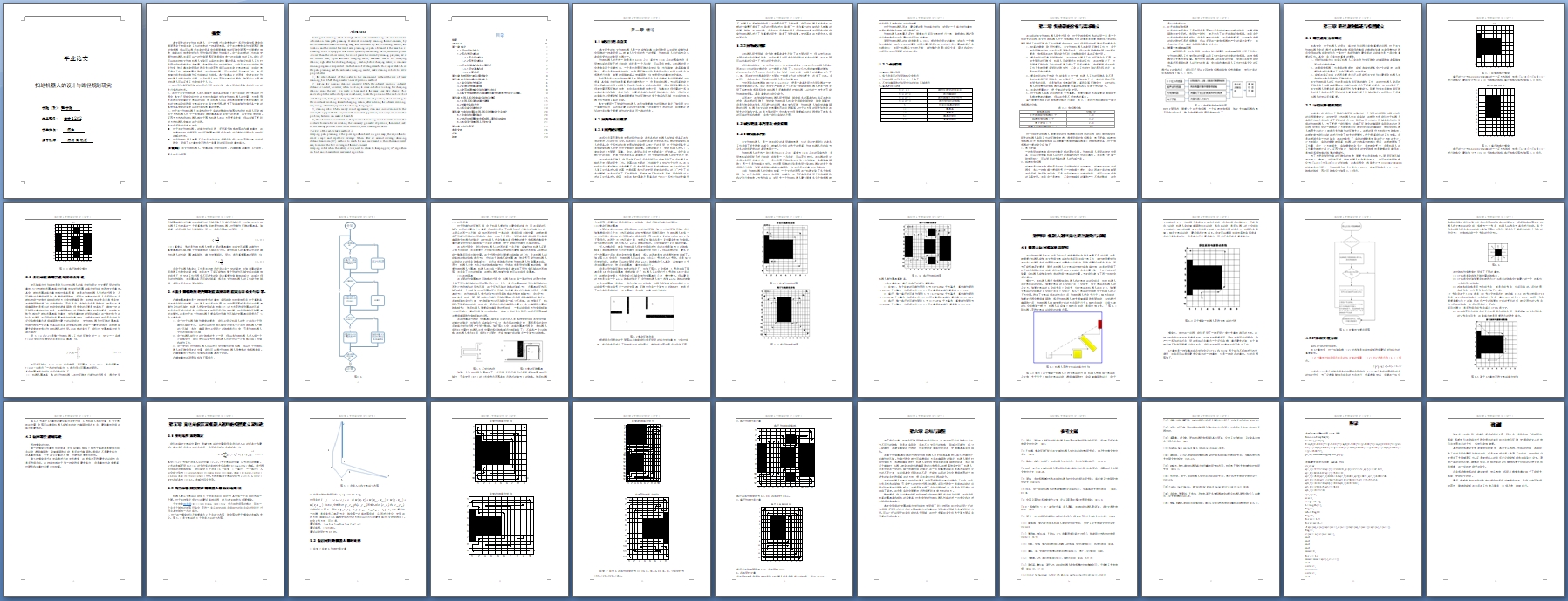扫地机器人的设计与路径规划研究

1.无需注册登录,支付后按照提示操作即可获取该资料.
2.资料以网页介绍的为准,下载后不会有水印.资料仅供学习参考之用.
密 惠 保
扫地机器人的设计与路径规划研究(任务书,开题报告,论文14000字)
摘要
本文研究的自主扫地机器人,是一种通过自身携带的一系列扫描传感器来获得周围会干涉到自身工作的信息的一种家用电器。由于自身携带有扫描周围环境的传感器,所以可以通过自身的设备来获得需要清洁的环境中周围一切需要的信息,借助这些信息来规划出待扫描的环境的扫地路径。由于有这样的工作机制使得扫地机器人自身可以一边扫描周围环境得到信息一边完成清洁的工作。我们还可以给这种自主扫地机器人安装可以监控自身电量的设备,比如让机器人工作时每隔一段时间检测一次电量,当电量低于一定的阈值时,自动开启充电功能并停止扫描,然后靠自身设置的程序去自动寻找到可以给自身充电的电站,完成充电环节的工作。随着电量的饱和,自主扫地机器人可以自动断开充电的工作,然后接着之前未完成的清扫工作继续运作起来。本文依靠以上的原理,来建立自主扫地机器人的路径规划问题,以及机器人自主寻找充电站的模型,然基于以上原理的机器人可以正常工作来服务于人们。
1、在对待扫描环境区域的边界进行界定的时候,本文用到的是集合表达方法的先行描述的方式。
2、在对于自主扫地机器人在不借助外部设备的帮助下自主完成寻找充电站的过程中,本文采用极坐标定位的方法来准确的规划处扫地机器人的位置,方法是预先在程序中设置好充电站的坐标,然后机器人可以在低电量需要充电时依靠已存在的充电站坐标找到充电站自主完成充电过程。避免了依靠诸如扫描设备一类的其他设备带来的误差以及时间和电量的浪费。
3、对于自主扫地机器人自身形状对于实验的影响比如圆形形状的机器人可能相比于方形机器人对于一些角落环境的覆盖率会有很大的差异,本文也有考虑到。正因为方形形状的机器人相比于圆形机器人在这方面更有优势,所以选择了更好的方形机器人来解决这个问题。
本文中采取的关键方法有:
对于自主扫地机器人的路径规划问题,采用基于栅格地图的内螺旋算法,这种算法比较简便而且对于环境覆盖问题中会产生的重复性问题也有比较好的解决方法。
对于扫地机器人电量不足并且在依靠自身程序和设备自主寻找充电站的过程中,用到了A*算法来寻找出一条最好的返回移动算法路径。
关键词:自主扫地机器人;全覆盖路径规划算法;内螺旋覆盖算法;A*算法;最优哈密尔顿图
Abstract
Intelligent cleaning robot through their own understanding of environmental information clean path planning. It at work, constantly scanning the environment, by environment information building map, then calculated by the positioning module, the location and the current has swept area, planning the path of cleaned at the same time. Cleaning robot is equipped with electric quantity monitoring device, when the power is lower than the critical value, the robot pause the currently running program, save the current state, open automatic charging mode, automatic search for charging stations, right after the docking charging. , reading before charging status, to continue running program is suspended. On the basis of existing research, this paper establishes the path planning and the automatic charging model, make cleaning robots to serve people better.
1, the establishment of the border to the environment without the use of laser scanning, but USES the geometric linear expression method.
2, looking for charging stations, generally USES the infrared emission, infrared distance is limited, however, when looking to come in before looking for charging stations along the wall, is a waste of time and at the same time take charge. This article adopts the method of polar coordinates, locate the position of the mobile robot is at this point, and a good charging stations have been set position, robot according to the coordinate working towards charging station, after entering the infrared receiving area, using infrared equipment for docking charge again.
3, cleaning robot USES mostly round appearance, clean and inconvenience to the corner, this paper USES a square with rounded appearance, not only can solve the problem, but also can make it beautiful.
4, the obstacles encountered in the process of cleaning robot to walk around the obstacles formula for calculating the boundary geometry expression, then went back to the starting position of the initial detection, then cleaning the house. [资料来源:http://THINK58.com]
The key of this article takes method is:
sweeping path planning is the spiral algorithm based on grid map, the algorithm to realize simple and repetitive coverage. When after all around coverage dumping distance transform (DT) method to search for and movement to the other uncovered area, to ensure the full coverage of the environment.
sweeping robot when the battery is low, need to return to charging pile, A * algorithm can find an optimal return movement algorithm.

目录
摘要 I
Abstract II
第一章 绪论 1
1.1研究目的及意义 1
1.2国内外研究现状 1
1.2.1国内研究现状 1
1.2.2国外研究现状 2
1.3研究的基本内容及必要说明 2
1.3.1研究基本内容 2
1.3.2必要说明 3
第二章 传感器的分析与需求确立 4
第三章 路径规划概述与模型建立 6
3.1路径规划方法概述 6
3.2环境区栅格化建模 6
3.3全区域覆盖路径规划算法及结论 8
3.4基于栅格地图的内螺旋覆盖算法的覆盖方法设计与结果。 9
第四章 机器人返回充电路径规划与求解 15 [资料来源:http://THINK58.com]
4.1机器人返回移动算法建模 15
4.2A*算法实现方法 17
4.3返回路径规划结论 19
第五章 充电站位置及机器人返回的模型建立及结论 20
5.1充电站位置的确定 20
5.2哈密尔顿圈模型求解机器人最短运动路线 20
5.3各房间扫地机器人用时计算 21
第六章 总结与展望 25
参考文献 26
附录 28
致谢 29 [资料来源:http://www.THINK58.com]
